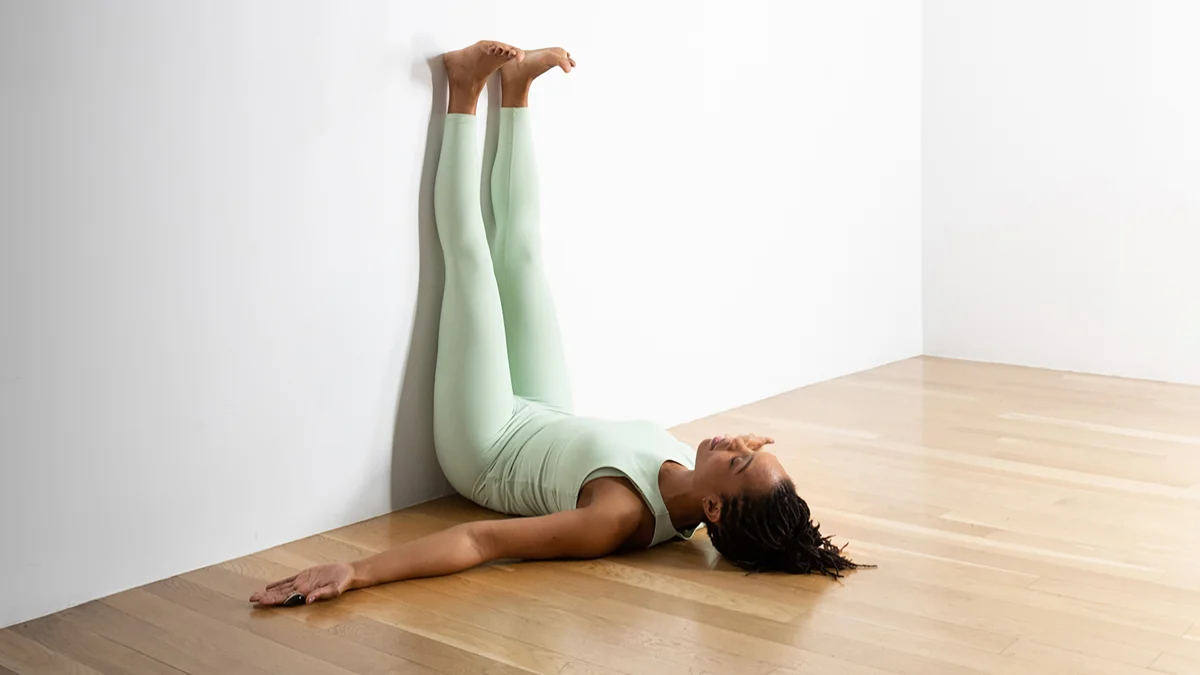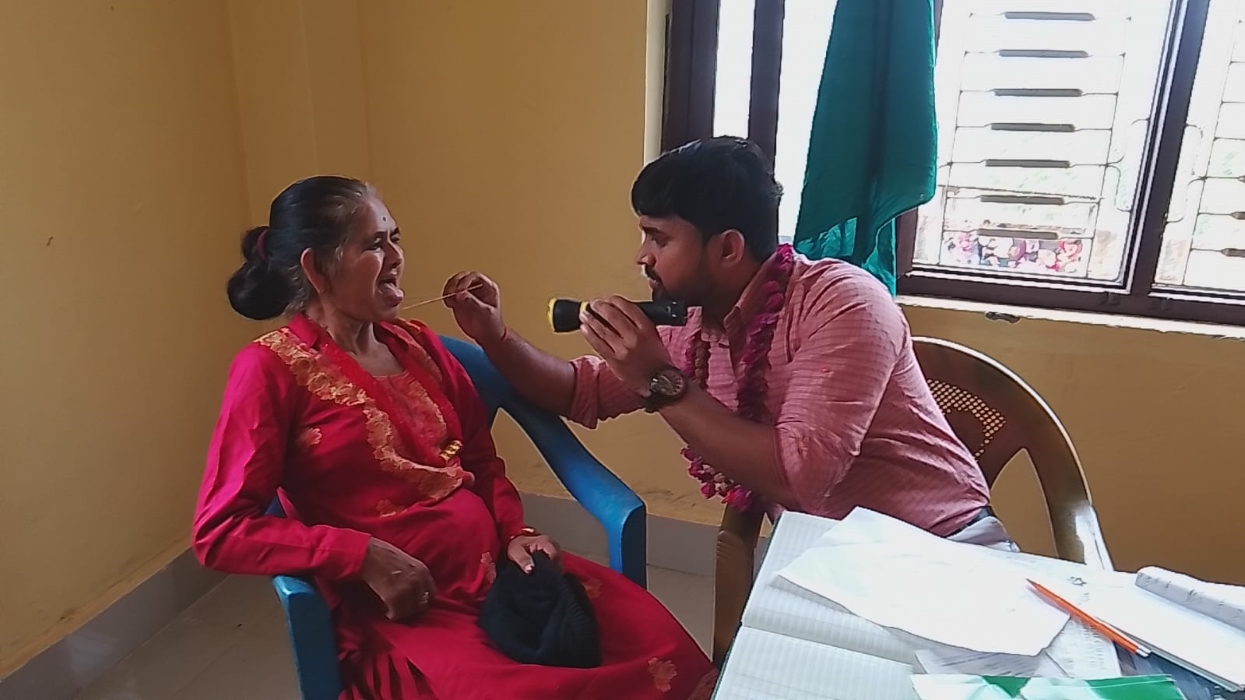Yoga pose you need: The health benefits of legs up the wall
Your circulatory system will thank you for trying this one.

If thinking about yoga brings to mind images of backbends and headstands, think again. You don’t have to be a yoga die-hard or even particularly flexible to reap the benefits of simpler, more accessible poses. One of them is viparita karani, often referred to as the legs-up-the-wall pose, which is exactly as it sounds: Your torso and head lie flat on the ground while your legs are inverted up a wall.
Robert Saper, MD, MPH, Chair of Wellness and Preventive Medicine, talks about what a legs-up-the-wall pose can do for your body and how to safely execute it, whether or not you’re a yogi in training.
Health benefits of legs-up-the-wall pose (viparita karani)
The legs-up-the-wall pose is one of several yoga poses known as inversion poses. “This means that the upper body is inverted from its normal, upright position,” Dr. Saper explains. Other examples include downward-facing dogs, shoulder stands and headstands.
In Sanskrit, viparita means “inverted” and karani translates to “in action.” When you do the legs-up-the-wall pose, then, you’re in an active inversion position. With your legs above the rest of your body, gravity gets to work on them in a way it simply can’t for most of the day.
And the legs-up-the-wall pose is accessible even to people who aren’t able to do other inversion poses. “The advantage of legs up the wall compared to a headstand or shoulder stand is that you’re able to achieve the benefits of inversion without stressing or straining your neck and head,” Dr. Saper explains. He cautions that anyone with chronic neck pain or any disorders of the spine in the neck region should not do shoulder stands or headstands.
He outlines the potential health benefits of the legs-up-the-wall pose.
It improves circulation
A common cause of leg swelling is venous insufficiency when your leg veins don’t effectively circulate blood from your legs back up toward your heart. Weak circulation is associated with blood pooling and retention of blood in your legs, which can raise your chances of blood clots — and, at the very least, some swelling and discomfort.
Even if you don’t have chronic venous insufficiency, standing or sitting all day may limit your body’s ability to easily circulate blood back up your body. But legs up the wall can help.
“The main benefit of viparita karani is that it puts back into circulation the bodily fluids stored in your legs,” Dr. Saper explains. “By inverting and holding that pose, it allows the return of blood flow and reduction of lower-leg swelling.”
It can help you de-stress
Research shows that yoga can, in general, have a positive impact on your body’s stress response systems, and restorative yoga poses like legs up the wall are intended to guide your body into a state of relaxation.
“Many patients describe anecdotally they find holding the pose is very calming,” Dr. Saper says. De-stressing is associated with better overall physical and mental health, and even a stronger immune system.
It could have additional benefits
If legs up the wall helps you relax, it may indeed help you feel better overall — but beware any sweeping claims that it’s some sort of cure-all, Dr. Saper warns. “Some people claim that it alleviates other conditions such as headaches and high blood pressure, but there’s no evidence of that.”
How often to do legs up the wall
“As a researcher of yoga and a yoga instructor, I recommend this pose as part of an overall restorative yoga practice, done toward the end of your practice,” Dr. Saper says.
The pose is safe to do as often as once or twice a day, whether as part of your regular yoga practice or as a stand-alone pose.
How to master legs-up-the-wall pose
“Initially, you should be instructed by a yoga teacher to make sure that you’re doing it safely and not straining your neck head or spine,” Dr. Saper advises. “But it’s relatively easy to do.” You can also learn from online yoga videos.
Here’s how to do legs-up-the-wall pose:
Ready your props: Place a blanket or yoga mat on the floor, next to the wall, and use a thin pillow for your head if needed.
Get in position: Lie down on the blanket or mat with your buttocks scooted up toward the wall. Your tailbone should remain on the floor, with your buttocks a few inches out from the wall. “Your back and head are simply aligned on the floor perpendicular to the wall, relaxed,” Dr. Saper explains.
Feel the stretch: The backs of your legs should rest against the wall, with your knees relaxed and your feet parallel to the floor below. You should feel a light stretch in your legs, but it should not be painful.
Take it easy: Relax and breathe deeply as you hold the pose. “I recommend holding it for a similar length as other yoga poses — anywhere up to two to three minutes,” Dr. Saper says. You can do it for longer, though, if you’d like.
Come out of the pose slowly: When you’re done, move carefully into a seated position and sit quietly for at least 30 seconds. “You don’t want to rapidly come out of out of an inversion pose,” Dr. Saper wants.
Who shouldn’t try legs up the wall
As with any yoga posture, there are some risks associated with doing legs up the wall. Avoid the pose if you have been diagnosed with the following conditions.
Glaucoma
Inversion poses like legs up the wall have been shown to increase intraocular pressure — the fluid pressure within your eyes — making them unsafe for people with glaucoma. “The pressure comes back down to normal after you resume a normal sitting position,” Dr. Saper says, “but if you have glaucoma, the pose should not be done at all.”
Conditions that cause excessive fluid retentio
People with specific conditions that cause excessive fluid volume in their bodies should also largely stay away from legs up the wall. “They should either not do this pose, or do it very sparingly with guidance from their physician because there’s such a large amount of fluid that could be returned to the circulation it could strain the heart,” Dr. Saper says. These conditions include:
- Congestive heart failure
- Kidney failure
- Liver failure or cirrhosis
Uncontrolled high blood pressure
If you have uncontrolled high blood pressure, you’ll also want to avoid legs up the wall, as this pose can further increase your blood pressure. But feel free to revisit it after working with a doctor to stabilize your blood pressure.
-Health Essentials









